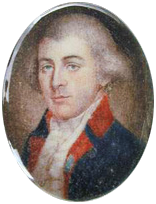Philip Reed
Philip Reed | |
|---|---|
 | |
| Member of the U.S. House of Representatives from Maryland's 6th district | |
| In office March 19, 1822 – March 3, 1823 | |
| Preceded by | Jeremiah Cosden |
| Succeeded by | George Edward Mitchell |
| Member of the U.S. House of Representatives from Maryland's 7th district | |
| In office March 4, 1817 – March 3, 1819 | |
| Preceded by | Robert Wright |
| Succeeded by | Stevenson Archer |
| United States Senator from Maryland | |
| In office November 25, 1806 – March 4, 1813 | |
| Preceded by | Robert Wright |
| Succeeded by | Robert H. Goldsborough |
| Personal details | |
| Born | 1760 near Chestertown, Province of Maryland, British America |
| Died | November 2, 1829 (aged 68–69) Huntingtown, Maryland, U.S. |
| Political party | Democratic-Republican |
Philip Reed (1760 – November 2, 1829) was a United States Senator representing Maryland from 1806 to 1813.
Born near Chestertown in the Province of Maryland in 1760, Reed completed preparatory studies and served with the Continental Army during the American Revolutionary War, attaining the rank of captain of infantry. He participated in the Battle of Stony Point in 1779, and later attested to having cut off the head of an American deserter so that it could be displayed to the troops as a deterrent.[1] Reed was seriously wounded at the Battle of Camden in 1780. He was a member of the Maryland House of Delegates in 1787, sheriff of Kent County, Maryland from 1791 to 1794, and also member of the executive council of Maryland from 1805 to 1806.
Reed was elected as a Democratic-Republican to the United States Senate in 1806 to fill the vacancy caused by the resignation of Robert Wright. He was reelected the same year and served from November 25, 1806 to March 3, 1813. Although he voted, on June 17, 1812, against declaring war on Britain, Reed served as a lieutenant colonel of the Twenty-first Regiment of the Maryland Militia and later as lieutenant colonel commandant. He led a successful defense in the Battle of Caulk's Field in August 1814.
After the War, Reed was elected to the House of Representatives in the Fifteenth Congress, serving from March 4, 1817 to March 3, 1819. He was an unsuccessful candidate for reelection in 1818 to the Sixteenth Congress, but successfully contested the election of Jeremiah Cosden to the House in the Seventeenth Congress and served the remainder of the term from March 19, 1822 to March 3, 1823.
In 1828, he served as vice president of the Maryland Society of the Cincinnati.
He died in Huntingtown, Maryland, and is interred in the cemetery of Christ Church near Chestertown.
See also[]
References[]
- ^ Letter of Philip Reed to Noah's Register, 1828, defending Gen. Andrew Jackson's execution of deserters.
- United States Congress. "Philip Reed (id: R000125)". Biographical Directory of the United States Congress.
External links[]
- 1760 births
- 1829 deaths
- Continental Army soldiers
- Members of the Maryland House of Delegates
- Members of the United States House of Representatives from Maryland
- United States senators from Maryland
- People from Chestertown, Maryland
- Maryland Democratic-Republicans
- Democratic-Republican Party United States senators
- Democratic-Republican Party members of the United States House of Representatives
